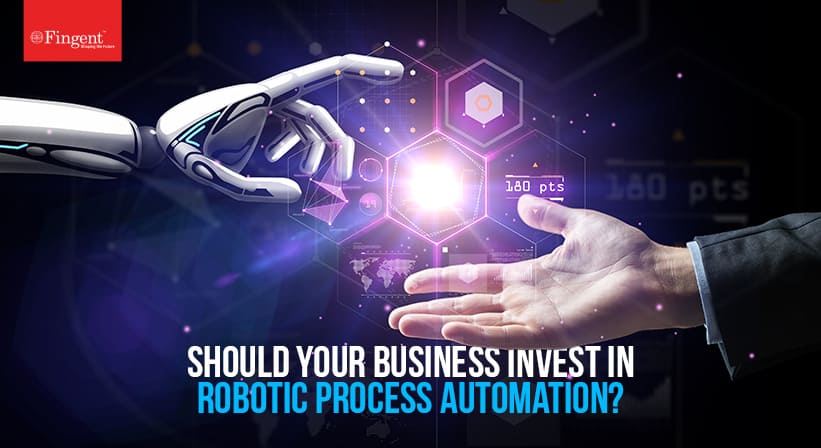What Makes a Business Process Apt for Automation
How to Determine If Your Business Process Qualifies for Automation
A large number of businesses are adopting Robotic Process Automation (RPA) today to drive their critical enterprise operations quickly and affordably. While RPA offers a wide array of automation capabilities, you need to first identify which of your business processes are ideal to be automated so that your business enhances operational efficiencies to deliver positive outcomes. For instance, some companies achieve better outcomes when implementing rule-based automation when compared to non-standardized, variable types. Forrester recently reported that RPA Market will reach USD 2.9 billion by 2021, which makes it one of the most sought-after enterprise technologies. The picture is clear: it is crucial for companies to know the different ways to determine which of their business processes need automation.
This post attempts to walk you through the major questions and answers which can help you decide the candidature of a process for Robotic Process Automation:
Criteria to determine if a process is fit for RPA automation
Deciding whether a business process requires RPA implementation or not depends on two criteria:
- Process Fitness
- Automation Complexity
Process Fitness
To determine if a process is reasonable enough to offer tangible results by implementing RPA, it is first critical to understand the process type being considered. RPA can automate only clear and well-defined processes. For this, it is first required to know which category the workforce’s tasks belong to:
Repetitive/ Automatable processes
Automatable processes relieve the human workforce from performing repetitive tasks such as clerical and data entry works or data manipulation tasks. Automating such redundant tasks allows human workers to focus on core, value-adding functions.
We can differentiate four types of processes:
- Manual and Non-Repetitive Processes: The steps are performed by humans and are performed every time the process is executed.
- Manual and Repetitive Processes: The steps are performed by the user. A few of these steps are the same every time they are executed.
- Semi-Automated and Repetitive Processes: A few of the steps in these processes are already automated, using Macros, Outlook rules, and so on.
- Automated Processes: These processes are those that have already been automated by technologies other than Robotic Process Automation.
While the above four are somewhat repetitive/ automatable, there is another category: Manual Or Non-Repetitive processes that are not great candidates for RPA. This is because these processes need to stay manual or are non-repetitive due to the high exception rate or factors that cannot be integrated into business logic.
Rule-Based Processes
For a process to be automated, it should be rules-based. Human-made rules are applied based on which the system executes the process. Rules can be related to storing, sorting, and manipulating data. The rules-based system is a logical program that uses a predefined logic to interpret data or make decisions. These processes are always easy to use and understand. The rules-based processes have an exception rate which is either low or can be included in the business logic as well.
Standard Input Processes
Standard input processes are those that need to be either electronic/ easily readable or are readable using a particular technology that can be associated with RPA. An example of a standard input process is the OCR. The Optical Character Recognition or OCR algorithms have processes whereby printed or handwritten documents are scanned and analyzed automatically and the text data is converted into editable formats for efficient processing. Using OCR is a much more reliable way to automate tasks such as invoice processing.
Stable Processes
Stable processes are processes that have remained the same over some time and no changes are expected in the coming months. These processes are good candidates for automation, provided they meet with other critical criteria as well. The output of these processes is fairly predictable.
Related Reading: Robotic Process Automation: Choosing The Right Solution For Your Business
Automation Complexity
It’s also crucial to analyze the complexity of a process to see if it’s fit for automation. The complexity of deciding to automate a process depends on several factors such as the number of applications or systems, the number of times human intervention is required, or even the number of steps required to execute the given task.
Following are some of the factors you need to look at:
- Number Of Screens: RPA in this scenario works by programming the robot to perform functions at the screen level. That is, when the screen changes, the logic is taught. The number of screens is directly proportional to the elements to be captured and configured. For instance, the higher the number of screens, the larger is the number of elements to be captured and configured before process automation.
- Types Of Applications: There are different types of applications. Some can be easily automated such as the Microsoft Office Suite or Java. Some other processes require complex automation effort, such as Mainframe applications.
- Business Logic Scenarios: The complexity in automating a process increases with the increase in the number of decision points within the business logic.
- Types And Number Of Inputs: Standard Inputs are desirable. For instance, an invoice that is a standard input and needs to be configured for each supplier will be impacted by automation. On the other hand, non-standard inputs will have varying complexity grades. Among these, free text is the most complex one.
Using the above-mentioned four factors, the processes can be split into four major categories:
-
No RPA Processes
These are processes in which change happens frequently. The system environment is volatile and multiple non-digital or manual actions are needed.
-
Semi-Automation Processes
Semi-automated processes are fragmented down into multiple steps that are automated. These steps include the ones that need to be manual such as the validations of physical security tokens.
-
High-Cost RPA Processes
These processes are digital and can be automated. High-cost RPA processes either make use of some complex technologies such as Optical Character Recognition or OCR or require advanced skills in programming.
-
Zero-Touch Automation Processes
These processes are digital and involve a highly static system and process environment. This makes it easy to be broken into instructions and define simple triggers.
The Stages In RPA Implementation
RPA offers a multitude of ways in which the degree of automation can be increased. There are commonly 6 stages involved in RPA implementation:
- RPA Preparation: Here, the processes are defined, assessed, prioritized, and then the plan is implemented.
- Designing The Solution: Here, each process to be automated is documented ( as “as is” and ”to be”). The architecture is now created and reviewed. This is followed by the preparation of test scenarios and environments. With this, the solution design is now created and documented for each process.
- Building the RPA: In RPA building, the processes are automated, the workflows are tested, and validated. This is followed by the preparation of the UAT.
- Testing the RPA: The UAT is now performed, followed by the debugging of the workflows. The process is now ready to be signed off.
- Stabilizing the RPA: In this phase, initially, the Go-Live is prepared. The process is then moved to production, monitored, and measured. The lessons learned are now documented.
- Constant Improvement Phase: This phase involves the assessment of process automation performance. This is followed by tracking the benefits and managing the changes.
Download our latest white paper: How RPA Simplifies Business Operations
Utilizing RPA Effectively
Every company planning to use/ already using RPA applies automation to fulfill different operational goals. While businesses at the beginning of their RPA journey want to uncomplicate and rapidly execute their workflows, the veterans in RPA might wish to expand the scope of their existing automation solution and improve their regulatory compliance. Each one wants to leverage technology differently.
Whatever your goal is, Fingent helps businesses in leveraging RPA to deliver high business value, drive significant cost benefits, and enable technology to have a positive impact on your operational activities. Get in touch with us to know how we can realize your automation goals.
Stay up to date on what's new

Recommended Posts

09 Jan 2023 B2B
5 Advanced Technologies Inevitable For Your Business Today
The strategic significance of advanced technologies as a critical business component is recognized by enterprises like never before. Besides business modernization and cost reduction, advanced technologies allow you to compensate……

04 Oct 2022 B2B
5 Advanced Business Technologies You Should’nt Miss Out When Strategizing Brand Value and Competency!
The strategic significance of advanced technologies as a critical business component is recognized by enterprises like never before. Besides business modernization and cost reduction, advanced technologies allow you to compensate……

04 Mar 2022 B2B
Deploying RPA for Finance, Healthcare & IT Operations
Robotic Process Automation (RPA) is not just a “nice-to-have” option anymore. If you want to remain competitive it is an absolute necessity. As a most promising technology enabler, RPA helps……

27 Nov 2021 B2B
Is It the Right Time for Your Business to Invest in Robotic Processing Automation?
As digitalization is gaining a lot of significance, many enterprises are turning to emerging technologies such as Robotic Process Automation(RPA) to streamline their operations and reduce costs. RPA automates mundane……
Featured Blogs
Stay up to date on
what's new













